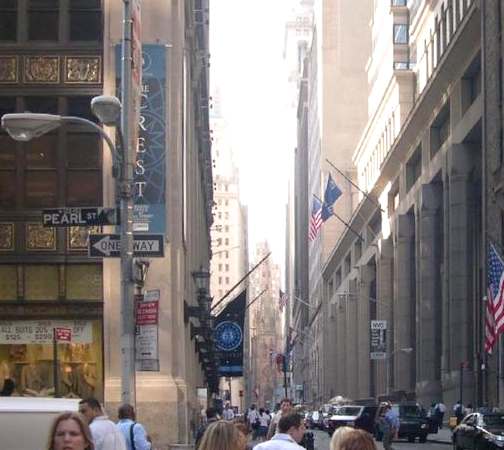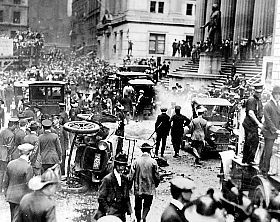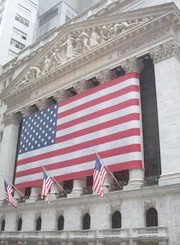|
WALL STREET
|
||
|
Wall Street is the name of a narrow street in lower Manhattan running east from Broadway downhill to the East River. Considered to be the historical heart of the Financial District, it was the first permanent home of the New York Stock Exchange.
The phrase "Wall Street" is also used as a metonym to refer to American financial markets and financial institutions as a whole. Interestingly, most New York financial firms are no longer headquartered on Wall Street, but elsewhere in lower or midtown Manhattan, Fairfield County, Connecticut, or New Jersey. JPMorgan Chase, the last major holdout, sold its headquarters tower at 60 Wall Street to Deutsche Bank in November 2001.
History
The name of the street derives from the fact that during the 17th century, it formed the northern boundary of the New Amsterdam settlement. There, the Dutch had constructed a crude wall of timber and earthwork in 1652. The wall was ostensibly meant as a defense against attack from Lenape Indians, New England colonists, and the British, but it was actually used to keep the colony's black slaves from escaping. The wall was dismantled by the British in 1699.
In the late 18th century, there was a buttonwood tree at the foot of Wall Street under which traders and speculators would gather to trade informally. This was the origin of the New York Stock Exchange.
The Wall Street Journal, named in reference to the actual street, is an influential international daily business newspaper published in New York City. For many years, it had the widest circulation of any newspaper in the United States, although it is currently second to USA Today. It is owned by Dow Jones & Company.
Decline and revitalization
The Manhattan Financial District is one of the largest business districts in the United States, and second in New York City only to Midtown. In the late 19th and early 20th centuries, the corporate culture of New York was a primary center for the construction of skyscrapers (rivaled only by Chicago). The Financial District, even today, actually makes up a distinct skyline of its own, separate from but not soaring to quite the same heights as its counterpart a few miles to the north (New York City actually has three distinct skylines, the third being Brooklyn Heights).
September 16, 1920: a bomb exploded in front of the headquarters of J.P. Morgan Inc. at 23 Wall Street killing 40 and injuring 300 people
Built in 1914, 23 Wall Street was known as the "House of Morgan" and for decades the bank's headquarters was the most important address in American finance. At noon, on September 16, 1920, a bomb exploded in front of the bank, killing 40 and injuring 400. Shortly before the bomb went off a warning note was placed in a mailbox at the corner of Cedar Street and Broadway. The warning read: Remember we will not tolerate any longer. Free the political prisoners or it will be sure death for all of you. American Anarchists Fighters. While theories abound about who was behind the Wall Street bombing and why they did it, after twenty years investigating the matter, the FBI rendered the file inactive in 1940 without ever finding the perpetrators.
By the Great Depression, new development of the Financial District had stagnated. The construction of the World Trade Center was one of the few major projects undertaken during the last three quarters of the 20th Century and, financially, it was never terribly successful. Some point to the fact that it was actually a government-funded project, constructed by the Port Authority of New York and New Jersey with the intention of spurring economic development in downtown. All the tools necessary to international trade were to be housed in the complex. However, at the beginning much of the space remained vacant.
Nonetheless, some large and powerful firms did purchase space in the World Trade Center. Further, it attracted other powerful businesses to the immediate neighborhood. In some ways, it could be argued that the World Trade Center changed the nexus of the Financial District from Wall Street to the Trade Center complex. When the World Trade Center was destroyed in the September 11, 2001 attacks, it left somewhat of an architectural void as new developments since the 1970s had played off the complex aesthetically. The attacks, however, contributed to the loss of business on Wall Street, due to temporary-to-permanent relocation to New Jersey and further decentralization with establishments transferred to cities like Chicago and Boston.
Wall Street itself and the Financial District as a whole are crowded with highrises by any standard of measure. Further, the loss of the World Trade Center has actually spurred development in the Financial District on a scale that hasn't been seen in decades. This is in part due to tax incentives provided by the federal, state and local governments to encourage development. A new World Trade Center complex, centered on Daniel Liebeskind's Memory Foundations plan, is in the early stages of development and one building has already been replaced. The centerpiece to this plan is the 1,776-foot tall Freedom Tower. New residential buildings are already sprouting up, and buildings that were previously office space are being converted to residential units, also benefiting from the tax incentives. Better access to the Financial District is planned in the form of a new commuter rail station and a new downtown transportation center centered on Fulton Street.
New York Stock Exchange (June 2003)
Wall Street today
To say that a corporation is a "Wall Street company" today doesn't necessarily mean that the company is physically located on Wall Street. It more likely means that the firm deals with financial services; such a firm could be headquartered in many places across the globe. Today, much of Wall Street's workforce tends to be made up of professionals working in the fields of law or finance who work for medium- to large-sized corporations. Many of the nearby businesses are local companies and chain stores that cater to the tastes of professionals and to the needs of the workforce. Most people who work in the Financial District commute in from suburbs in Long Island, Connecticut, Pennsylvania, New Jersey, and the northern Hudson Valley.
Wall Street's culture is often criticized as being rigid. This is a decades-old stereotype stemming from the Wall Street's establishment's protection of their interests, and the link to the WASP establishment. More recent criticism has centered on structural problems and lack of a desire to change well-established habits. Wall Street's establishment resists government oversight and regulation. At the same time, New York City has a reputation as a very bureaucratic city, which makes entry into the neighborhood difficult or even impossible for middle class entrepreneurs. Finally, the New York Stock Exchange itself remains the last great holdout where trading is done entirely on the floor rather than electronically. There is, ironically, no longer really any need for Wall Street the institution to be located on Wall Street the street, except perhaps for prestige. Stocks could easily be traded almost anywhere.
Since the founding of the Federal Reserve banking system, the Federal Reserve Bank of New York in the Financial District has been the point where monetary policy in the United States is implemented (although it's decided in Washington, D.C. by the Federal Reserve Bank's Board of Governors). As such, New York State is today unique in that it's the only state that constitutes its own district of the Federal Reserve Banking system. This is perhaps partly owed to population distribution in the United States of the time, however. Until the 1960s, New York was the most populated state in the U.S.; it now ranks third, behind California and Texas. The NY Federal Reserve's president is the only regional Bank president with a permanent vote and is traditionally selected as its vice chairman. The bank has a gold vault 80 feet (25 m) beneath the street. This depository is the largest in the world, larger even than Fort Knox.
Buildings
Wall Street's architecture is generally rooted in the Gilded Age, though there are also some art deco influences in the neighborhood. Landmark buildings on Wall Street include Federal Hall, and the New York Stock Exchange at the corner of Broad Street.
Nelson Kruschandl - Entrepreneur looking for investors
SOLAR COLA as an INVESTMENT OPPORTUNITY?
The soft drinks market is a tough place to do business, unless you have something different to offer and the marketing muscle to match.
For nearly 100 years Coca Cola and Pepsi Cola have dominated the marketplace with similar products, but at this time they are losing ground to newer drinks with something more to offer. Each company spends around $600-800 million dollars a year to maintain its market position. The advertising centers around sport and music, with a scattering of irregular television campaigns. Each company launches (or attempts to launch) new brands every year. So far, they have not proved as successful as their regular cola brands and brand loyalty is an obstacle.
Red Bull, although in a different drinks category, spends not quite as much on advertising, but has managed to acquire instant status and volume sales from sponsoring formula one, the Darpa Desert Challenge, and now the New Jersey MetroStars football team.
A taste for adventure capitalists
Solar Cola - the healthier cola alternative
Solar Cola, apart from it's contemporary name, is a healthier cola based drink. Just as refreshing, it contains a unique blend of added ingredients as an aid to good health and energy levels. The company contributes to and sponsors alternative projects, to include this website, featuring movies, music and several thousand pages of general information, which generates in excess of 3 million visits a month already. Recent acquisitions include the rights to the Solar Navigator World Electric Challenge - 2009/10, and also the new Bluebird Electric land speed record car for 2007/8. The company may also sponsor the London to Brighton Solar Car Run in 2008 (dependent on the number of university entries received).
It is thought that this marketing strategy will equal several hundred thousand dollars of conventional Ad Agency spending. As an example of the kind of media coverage such nautical antics generate, you have only to look at the newspapers when Ellen Macarthur completed her world circumnavigation. The same was true for Sir Francis Chichester and Sir Robin Knox-Johnston.
The design of the Solar Cola can is copyright protected, with trademark applications in the USA, Australia and Europe pending in Class 32 and granted rights in the UK. Introduction of the drink is held in abeyance pending official launch of one or other sponsored projects, which will be activated when the time is right, such activation to coincide with the market introduction of the drink.
Solar Cola PLC is shortly to be activated for online investment as their trading arm. The company is forecast to produce excellent results for investors, with sustained growth to be followed by an eventual flotation on the Stock Markets of the world in the next five years. At this point estimates suggest investors will reap substantial gains - in line with international Licensing expectations.
Solar Cola Ltd is managing the funding requirement for the trading company. They are looking for medium term or seed investment between £4-5 million in total to kick start phase two of the venture. Accordingly, this may require co-operation between, and several Angel investors, or a mix of Equity House and private investors.
If you are a Business Angel, or Equity House, looking for an opportunity with the potential for good returns, please contact SOLAR COLA LTD for details of their business plan. Or for and informal chat, please ask for the funding project manager: Nelson Kruschandl
+ 44 (0) 1323 831727 +44 (0) 7905 147709
MONEY FINDER
REFERENCES and LINKS:
SolarNavigator is to be equipped with the SNAV intelligent autonomous navigation system. This system is thought to be the only system under development that is COLREGs compliant.
|
||
|
This website is copyright © 1991- 2013 Electrick Publications. All rights reserved. The bird logo and names Solar Navigator and Blueplanet Ecostar are trademarks ™. The Blueplanet vehicle configuration is registered ®. All other trademarks hereby acknowledged and please note that this project should not be confused with the Australian: 'World Solar Challenge'™which is a superb road vehicle endurance race from Darwin to Adelaide. Max Energy Limited is an educational charity working hard to promote world peace. |
||
|
AUTOMOTIVE | BLUEPLANET BE3 | ELECTRIC CARS | ELECTRIC CYCLES | SOLAR CARS | SOLARNAVIGATOR |




